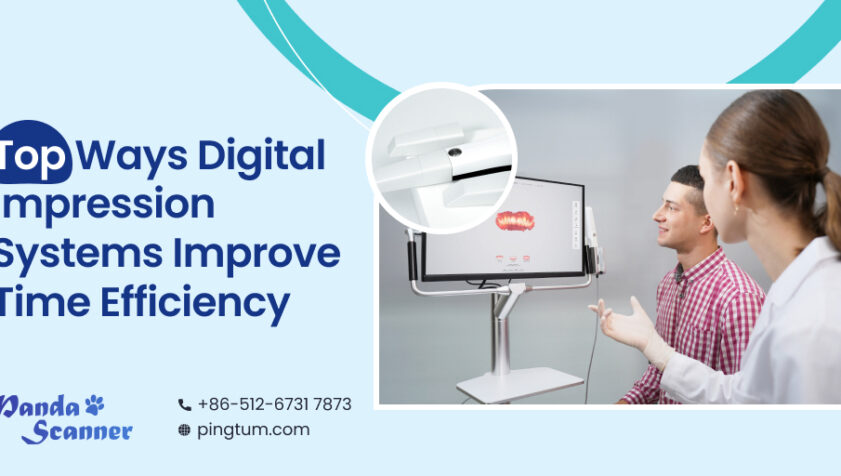Time is a valuable resource in the fast-paced world of contemporary dentistry that is highly valued by both professionals and patients. Traditional dental imprint techniques have long been a source of aggravation and inefficiency since they require messy materials, cause discomfort to patients, and take a lot of time. The world of dentistry is, however, quickly evolving thanks to the development of intraoral scanning technologies. That is why we are going to discuss how digital impression system is transforming the dentistry business by vastly improving time effectiveness, which ultimately helps both patients and dental practitioners.

The Traditional Impression Process: A Time-Consuming Challenge
In the past, dental impressions were taken more than once because of inaccuracies and patient discomfort. In those days, patients had to put up with unpleasant trays filled with sticky materials in their mouths. This procedure not only tested the dental team’s and patients’ patience, but it also extended treatment times significantly. Traditional impressions were hampered by delays and discrepancies during the arduous process of disinfection and shipment to laboratories after the ingredients were mixed and allowed to cure.
Why Intraoral Scanners Are a Game Changer in Dentistry?
A revolutionary innovation that directly addresses the time inefficiencies of conventional imprint procedures is the advent of intraoral scanners. These scanners take detailed 3D photographs of a patient’s mouth cavity in a couple of minutes using cutting-edge digital technology. The efficiency it adds to the dental process is demonstrated by how quickly intraoral scanning can be completed.
Rapid Data Collection
Intraoral scanning does not require physical ingredients, mixing, or set-up time. A thorough digital imprint is created in real-time with just a few scans of the scanner, saving both dental professionals and patients a significant amount of time.
Fast response
Intraoral scanners offer rapid response to make sure the recorded data is precise and comprehensive, unlike conventional impressions that must be developed and maybe retaken if wrong. This lowers the likelihood of mistakes and eliminates the need for further scans. Due to its profound influence on patient care, treatment planning, decision-making, and overall practise efficiency, rapid data collection is of utmost importance in dentistry. The capacity to gather data quickly thanks to numerous technological breakthroughs considerably improves the quality of dental treatment in a profession where precision, accuracy, and early interventions are crucial.
Improved Communication
A key component of successful dentistry is effective communication, which is essential for delivering high-quality patient care, developing trusting relationships with patients, and promoting teamwork among dental professionals. At all levels, from interactions between dentists and patients to inter-disciplinary cooperation, the area of oral healthcare necessitates clear and open communication.
A digital impression system speeds up data exchange between dental practitioners and laboratories, promoting simplified communication and cutting down on the wait time involved with shipping physical impressions.
Digital Treatment Planning
Virtual treatment planning is possible because of the instantaneous availability of intraoral images in digital format for dental practitioners. As a result, decisions may be made more quickly, and therapy can start sooner. Digital treatment planning serves as a link between cutting-edge technology and specialised patient care in the rapidly changing field of dentistry. Patients gain from better treatment outcomes, shorter treatment times, and a more enjoyable dental experience as dental practises continue to incorporate digital tools and procedures.
Effective Orthodontic Planning
Intraoral scans make it easier to create digital models for orthodontic treatment planning. This expedites the creation of aligners or braces, saving precious time for both practitioners and patients.
Reduced Chair Time
Patients also benefit from digital impression system’s effectiveness. Digital scanning with intraoral scanners like the Panda P3 intraoral scanner reduces patient discomfort and speeds up the entire treatment procedure, whereas traditional impressions can require many consultations and more time spent in the chair.
Final Thoughts
Dentistry is changing due to the time-saving benefits of intraoral scanning technology. Dental practitioners are seeing enhanced communication with laboratories, shorter treatment times, and simpler operations. Patients are benefiting from a more relaxing experience that involves fewer appointments and less sitting time. With the advancement of intraoral scanning technology, dentistry’s future seems to be one of accuracy, convenience, and speed, which will ultimately revolutionise the way oral healthcare is provided.
Adopting an intraoral scanner in practise is a strategic move towards maximising efficiency and saving priceless time in the quest to provide superior patient care and stay ahead in the cutthroat dentistry market.






